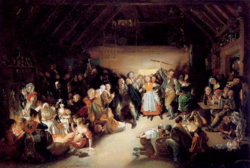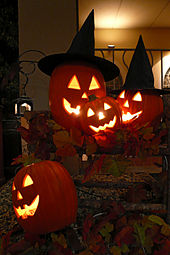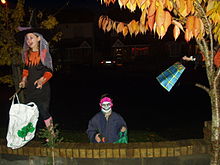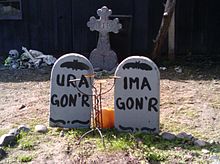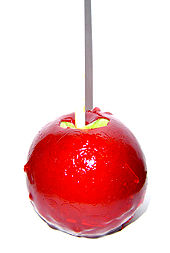- Halloween
-
Halloween
All Hallows' Eve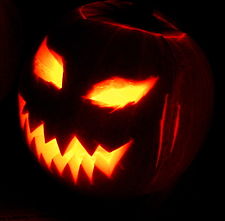
A Jack-o'-lanternAlso called All Hallows' Eve
All Saints' Eve
SamhainObserved by Western Christians & many non-Christians around the world[1] Date October 31 Celebrations Parades, Festivals, costume parties, trick-or-treating/guising, carving pumpkins, ghost tours, haunted attractions, Hell houses, bonfires, divination, apple bobbing, fireworks displays Observances Church services,[2] prayer,[3] fasting,[1] and vigils[4] Related to Samhain, All Saints' Day (cf. vigils) Hallowe'en (a shortening of All Hallows’ Evening),[5] also known as Halloween or All Hallows' Eve,[6] is a yearly holiday observed around the world on October 31, the night before All Saints' Day. Much like Day of the Dead celebrations, the Christian feast of All Hallows' Eve, according to some scholars, incorporates traditions from pagan harvest festivals and festivals honouring the dead, particularly the Celtic Samhain;[6][7][8] other scholars maintain that the feast originated entirely independently of Samhain.[9] Typical festive Halloween activities include trick-or-treating (also known as "guising"), attending costume parties, carving jack-o'-lanterns, lighting bonfires, apple bobbing, visiting haunted attractions, playing pranks, telling scary stories, watching horror films, as well as the religious observances of praying, fasting and attending vigils or church services.[3][2][4][1]
Contents
History
Etymology
The word Halloween is first attested in the 16th century and represents a Scottish variant of the fuller All-Hallows'-Even ("evening"), that is, the night before All Hallows' Day.[10] Although the phrase All Hallows' is found in Old English (ealra hālgena mæssedæg, mass-day of all saints), All-Hallows-Even is itself not attested until 1556.[10]
Pre-Christian influences
According to some scholars, the observance of Halloween or All Hallows' Eve combines pre-Christian and Christian traditions;[11] other scholars maintain "that Hallowe'en, as the eve of All Saints' Day, originated entirely independently of Samhain and some question the existence of a specific pan-Celtic religious festival which took place on 31st October/1st November."[9] Historian Nicholas Rogers, exploring the origins of Halloween, notes that while "some folklorists have detected its origins in the Roman feast of Pomona, the goddess of fruits and seeds, or in the festival of the dead called Parentalia, it is more typically linked to the Celtic festival of Samhain (pronounced sow-an or sow-in)", derived from the Old Irish Samuin meaning "summer's end".[12] Samhain was the first and by far the most important of the four quarter days in the medieval Irish and Scottish[13] calendar[14][15] and, falling on the last day of autumn, it was a time for stock-taking and preparation for the cold winter months ahead.[12] There was also a sense that this was the time of year when the physical and supernatural worlds were closest and magical things could happen.[14][15] To ward off these spirits, the Gaels built huge, symbolically regenerative bonfires and invoked the help of the gods through animal and perhaps even human sacrifice.[12]
Christian influences
Snap-Apple Night (1832) by Daniel Maclise.
Depicts apple bobbing and divination games at a Halloween party in Blarney, Ireland.Halloween is also thought to have been heavily influenced by the Christian holy days of All Saints' Day (also known as Hallowmas, All Hallows, and Hallowtide) and All Souls' Day.[16] Falling on November 1 and 2 respectively, collectively they were a time for honoring the saints and praying for the recently departed who had yet to reach heaven. By the end of the 12th century they had become days of holy obligation across Europe and involved such traditions as ringing bells for the souls in purgatory and "souling", the custom of baking bread or soul cakes for "all crysten [ christened ] souls".[17] It was traditionally believed that the souls of the departed wandered the earth until All Saints' Day, and All Hallows' Eve provided one last chance for the dead to gain vengeance on their enemies before moving onto the next world.[18] To avoid being recognised by a soul, Christians would wear masques and costumes to disguise themselves, following the lighted candles set by others to guide their travel for worship the next day.[18] Today, this practice has been perpetuated through trick-or-treating.[18]
In Britain the rituals of Hallowtide and Halloween came under attack during the Reformation as Protestants denounced purgatory as a "popish" doctrine incompatible with the notion of predestination.[16] In addition the increasing popularity of Guy Fawkes Night (5th November) from 1605 on saw Halloween become eclipsed in Britain with the notable exception of Scotland.[19] There and in Ireland, they had been celebrating Samhain and Halloween since the early Middle Ages,[13] and the kirk took a more pragmatic approach towards Halloween, viewing it as important to the life cycle and rites of passage of local communities and thus ensuring its survival in the country.[19] North American almanacs of the late 18th and early 19th century give no indication that Halloween was recognized as a holiday.[20] The Puritans of New England, for example, maintained strong opposition to the holiday[20] and it was not until the mass Irish and Scottish immigration during the 19th century that the holiday was introduced to the continent in earnest.[20] Initially confined to the immigrant communities during the mid-19th century, it was gradually assimilated into mainstream society and by the first decade of the 20th century it was being celebrated coast to coast by people of all social, racial and religious backgrounds.[21]
Symbols
Development of artifacts and symbols associated with Halloween formed over time. For instance, the carving of jack-o'-lanterns springs from the Christian souling custom of carving turnips into lanterns as a way of remembering the souls held in purgatory.[22] The turnip has traditionally been used in Ireland and Scotland at Halloween,[23][24] but immigrants to North America used the native pumpkin, which is both much softer and much larger – making it easier to carve than a turnip.[23] Subsequently, the mass marketing of various size pumpkins in autumn, in both the corporate and local markets, has made pumpkins universally available for this purpose. The American tradition of carving pumpkins is recorded in 1837[25] and was originally associated with harvest time in general, not becoming specifically associated with Halloween until the mid-to-late 19th century.[26]
The imagery of Halloween is derived from many sources, including national customs, works of Gothic and horror literature (such as the novels Frankenstein and Dracula), and classic horror films (such as Frankenstein and The Mummy).[27] Among the earliest works on the subject of Halloween is from Scottish poet John Mayne in 1780, who made note of pranks at Halloween; "What fearfu' pranks ensue!", as well as the supernatural associated with the night, "Bogies" (ghosts), influencing Robert Burns' Halloween 1785.[28] Elements of the autumn season, such as pumpkins, corn husks, and scarecrows, are also prevalent. Homes are often decorated with these types of symbols around Halloween.
Halloween imagery includes themes of death, evil, the occult or mythical monsters.[29] Black and orange are the holiday's traditional colors.
Trick-or-treating and guising
Trick-or-treating is a customary celebration for children on Halloween. Children go in costume from house to house, asking for treats such as candy or sometimes money, with the question, "Trick or treat?" The word "trick" refers to a (mostly idle) "threat" to perform mischief on the homeowners or their property if no treat is given. In some parts of Scotland children still go guising. In this custom the child performs some sort of trick, i.e. sings a song or tells a ghost story, to earn their treats.
The practice of dressing up in costumes and begging door to door for treats on holidays dates back to the Middle Ages and includes Christmas wassailing. Trick-or-treating resembles the late medieval practice of souling, when poor folk would go door to door on Hallowmas (November 1), receiving food in return for prayers for the dead on All Souls' Day (November 2). It originated in Ireland and Britain,[17] although similar practices for the souls of the dead were found as far south as Italy.[30] Shakespeare mentions the practice in his comedy The Two Gentlemen of Verona (1593), when Speed accuses his master of "puling [whimpering or whining] like a beggar at Hallowmas."[31]
In Scotland and Ireland, Guising – children disguised in costume going from door to door for food or coins – is a traditional Halloween custom, and is recorded in Scotland at Halloween in 1895 where masqueraders in disguise carrying lanterns made out of scooped out turnips, visit homes to be rewarded with cakes, fruit and money.[24] The practice of Guising at Halloween in North America is first recorded in 1911, where a newspaper in Kingston, Ontario reported children going "guising" around the neighborhood.[32]
American historian and author Ruth Edna Kelley of Massachusetts wrote the first book length history of the holiday in the U.S; The Book of Hallowe'en (1919), and references souling in the chapter "Hallowe'en in America";
The taste in Hallowe'en festivities now is to study old traditions, and hold a Scotch party, using Burn's poem Hallowe'en as a guide; or to go a-souling as the English used. In short, no custom that was once honored at Hallowe'en is out of fashion now.[33]
In her book, Kelley touches on customs that arrived from across the Atlantic; "Americans have fostered them, and are making this an occasion something like what it must have been in its best days overseas. All Halloween customs in the United States are borrowed directly or adapted from those of other countries".[34]
While the first reference to "guising" in North America occurs in 1911, another reference to ritual begging on Halloween appears, place unknown, in 1915, with a third reference in Chicago in 1920.[35]
The earliest known use in print of the term "trick or treat" appears in 1927, from Blackie, Alberta, Canada:
Hallowe'en provided an opportunity for real strenuous fun. No real damage was done except to the temper of some who had to hunt for wagon wheels, gates, wagons, barrels, etc., much of which decorated the front street. The youthful tormentors were at back door and front demanding edible plunder by the word “trick or treat” to which the inmates gladly responded and sent the robbers away rejoicing.[36]
The thousands of Halloween postcards produced between the turn of the 20th century and the 1920s commonly show children but do not depict trick-or-treating.[37] The editor of a collection of over 3,000 vintage Halloween postcards writes, "There are cards which mention the custom [of trick-or-treating] or show children in costumes at the doors, but as far as we can tell they were printed later than the 1920s and more than likely even the 1930s. Tricksters of various sorts are shown on the early postcards, but not the means of appeasing them".[38] Trick-or-treating does not seem to have become a widespread practice until the 1930s, with the first U.S. appearances of the term in 1934,[39] and the first use in a national publication occurring in 1939.[40]
Costumes
Halloween costumes are traditionally modeled after supernatural figures such as monsters, ghosts, skeletons, witches, and devils. Over time, the costume selection extended to include popular characters from fiction, celebrities, and generic archetypes such as ninjas and princesses.
Dressing up in costumes and going "guising" was prevalent in Scotland at Halloween by the late 19th century.[24] Costuming became popular for Halloween parties in the US in the early 20th century, as often for adults as for children. The first mass-produced Halloween costumes appeared in stores in the 1930s when trick-or-treating was becoming popular in the United States.
Halloween costume parties generally fall on, or around, 31 October, often falling on the Friday or Saturday prior to Halloween.
UNICEF
Main article: Trick-or-Treat for UNICEF"Trick-or-Treat for UNICEF" has become a common sight during Halloween in North America. Started as a local event in a Northeast Philadelphia neighborhood in 1950 and expanded nationally in 1952, the program involves the distribution of small boxes by schools (or in modern times, corporate sponsors like Hallmark, at their licensed stores) to trick-or-treaters, in which they can solicit small-change donations from the houses they visit. It is estimated that children have collected more than $118 million for UNICEF since its inception. In Canada, in 2006, UNICEF decided to discontinue their Halloween collection boxes, citing safety and administrative concerns; after consultation with schools, they instead redesigned the program.[41][42]
Games and other activities
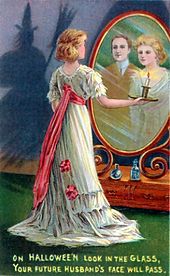 In this Halloween greeting card from 1904, divination is depicted: the young woman looking into a mirror in a darkened room hopes to catch a glimpse of the face of her future husband.
In this Halloween greeting card from 1904, divination is depicted: the young woman looking into a mirror in a darkened room hopes to catch a glimpse of the face of her future husband.
There are several games traditionally associated with Halloween parties. One common game is dunking or apple bobbing, which may be called "dooking" in Scotland[43] in which apples float in a tub or a large basin of water and the participants must use their teeth to remove an apple from the basin. A variant of dunking involves kneeling on a chair, holding a fork between the teeth and trying to drop the fork into an apple. Another common game involves hanging up treacle or syrup-coated scones by strings; these must be eaten without using hands while they remain attached to the string, an activity that inevitably leads to a very sticky face.
Some games traditionally played at Halloween are forms of divination. A traditional Scottish form of divining one's future spouse is to carve an apple in one long strip, then toss the peel over one's shoulder. The peel is believed to land in the shape of the first letter of the future spouse's name.[44] Unmarried women were told that if they sat in a darkened room and gazed into a mirror on Halloween night, the face of their future husband would appear in the mirror. However, if they were destined to die before marriage, a skull would appear. The custom was widespread enough to be commemorated on greeting cards[45] from the late 19th century and early 20th century.
Another game/superstition that was enjoyed in the early 1900s involved walnut shells. People would write fortunes in milk on white paper. After drying, the paper was folded and placed in walnut shells. When the shell was warmed, milk would turn brown therefore the writing would appear on what looked like blank paper. Folks would also play fortune teller. In order to play this game, symbols were cut out of paper and placed on a platter. Someone would enter a dark room and was ordered to put her hand on a piece of ice then lay it on a platter. Her "fortune" would stick to the hand. Paper symbols included: dollar sign-wealth, button-bachelorhood, thimble-spinsterhood, clothespin- poverty, rice-wedding, umbrella- journey, caldron-trouble, 4-leaf clover- good luck, penny-fortune, ring-early marriage, and key-fame.[46]
The telling of ghost stories and viewing of horror films are common fixtures of Halloween parties. Episodes of television series and Halloween-themed specials (with the specials usually aimed at children) are commonly aired on or before the holiday, while new horror films are often released theatrically before the holiday to take advantage of the atmosphere.
Haunted attractions
Haunted attractions are entertainment venues designed to thrill and scare patrons. Most attractions are seasonal Halloween businesses. Origins of these paid scare venues are difficult to pinpoint, but it is generally accepted that they were first commonly used by the Junior Chamber International (Jaycees) for fundraising.[47] They include haunted houses, corn mazes, and hayrides,[48] and the level of sophistication of the effects has risen as the industry has grown. Haunted attractions in the United States bring in an estimate $300–500 million each year, and draw some 400,000 customers, although press sources writing in 2005 speculated that the industry had reached its peak at that time.[47] This maturing and growth within the industry has led to more technically-advanced special effects and costuming, comparable with that of Hollywood films.[49]
Foods
Because the holiday comes in the wake of the annual apple harvest, candy apples (known as toffee apples outside North America), caramel or taffy apples are common Halloween treats made by rolling whole apples in a sticky sugar syrup, sometimes followed by rolling them in nuts.
At one time, candy apples were commonly given to children, but the practice rapidly waned in the wake of widespread rumors that some individuals were embedding items like pins and razor blades in the apples.[50] While there is evidence of such incidents,[51] they are quite rare and have never resulted in serious injury. Nonetheless, many parents assumed that such heinous practices were rampant because of the mass media. At the peak of the hysteria, some hospitals offered free X-rays of children's Halloween hauls in order to find evidence of tampering. Virtually all of the few known candy poisoning incidents involved parents who poisoned their own children's candy.[52]
One custom that persists in modern-day Ireland is the baking (or more often nowadays, the purchase) of a barmbrack (Irish: báirín breac), which is a light fruitcake, into which a plain ring, a coin and other charms are placed before baking. It is said that those who get a ring will find their true love in the ensuing year. This is similar to the tradition of king cake at the festival of Epiphany.
List of foods associated with the holiday:
- Barmbrack (Ireland)
- Bonfire toffee (Great Britain)
- Candy apples/toffee apples (Great Britain & Ireland)
- Candy corn, candy pumpkins (North America)
- Caramel apples
- Caramel corn
- Colcannon (Ireland)
- Novelty candy shaped like skulls, pumpkins, bats, worms, etc.
- Pumpkin, pumpkin pie, pumpkin bread
- Roasted pumpkin seeds
- Roasted sweet corn
- Soul cakes
Around the world
Main article: Halloween around the worldHalloween is not celebrated in all countries and regions of the world, and among those that do the traditions and importance of the celebration vary significantly. In Scotland and Ireland, traditional Halloween customs include children dressing up in costume going "guising", holding parties, while other practices in Ireland include lighting bonfires, and having firework displays.[53][54] Mass transatlantic immigration in the 19th century popularized Halloween in North America, and celebration in the United States and Canada has had a significant impact on how the event is observed in other nations. This larger North American influence, particularly in iconic and commercial elements, has extended to places such as South America, Australia,[55] New Zealand,[56] continental Europe, Japan, and other parts of East Asia.[57]
Religious perspectives
Christianity
Christian attitudes towards Halloween are diverse. In the Anglican Church, some dioceses have chosen to emphasize the Christian traditions associated with All Hallow's Eve.[58][59] Some of these practises include praying, fasting and attending worship services.[3][2][1]
Father, All-Powerful and Ever-Living God, today we rejoice in the holy men and women of every time and place. May their prayers bring us your forgiveness and love. We ask this through Christ our Lord. Amen. —All Hallow's Eve Prayer from the Liturgy of the Hours[60]
Other Protestant Christians also celebrate the holiday as Reformation Day, a day to remember the Protestant Reformation, alongside All Hallow's Eve or independently from it.[61][62] Oftentimes, "Harvest Festivals" or "Reformation Festivals" are held, in which children dress up as Bible characters or Reformers.[63]
Father Gabriele Amorth, a Vatican-appointed exorcist in Rome, has said, "if English and American children like to dress up as witches and devils on one night of the year that is not a problem. If it is just a game, there is no harm in that."[64] In more recent years, the Roman Catholic Archdiocese of Boston has organized a "Saint Fest" on the holiday.[65] Similarly, many contemporary Protestant churches view Halloween as a fun event for children, holding events in their churches where children and their parents can dress up, play games, and get candy for free. Many Christians ascribe no negative significance to Halloween, treating it as a purely cultural holiday devoted to celebrating "imaginary spooks" and handing out candy. To these Christians, Halloween holds no threat to the spiritual lives of children: being taught about death and mortality, and the ways of the Celtic ancestors actually being a valuable life lesson and a part of many of their parishioners' heritage.[66] In the Roman Catholic Church, Halloween's Christian connection is sometimes cited,[67] and Halloween celebrations are common in Catholic parochial schools throughout North America and in Ireland. Nevertheless, the Vatican has strongly condemned the traditions popularly associated with Halloween as being "pagan" and "anti-Christian".[68]
Some Christians feel concerned about the modern celebration of Halloween, and reject the holiday because they feel it trivializes – or celebrates – paganism, the occult, or other practices and cultural phenomena deemed incompatible with their beliefs.[69] A response among some fundamentalist and conservative evangelical churches in recent years has been the use of "Hell houses", themed pamphlets, or comic-style tracts such as those created by Jack T. Chick in order to make use of Halloween's popularity as an opportunity for evangelism.[65] Some consider Halloween to be completely incompatible with the Christian faith,[70] believing it to have originated as a pagan "Festival of the Dead".
Paganism
Celtic Neopagans consider the season a holy time of year.[71] Celtic Reconstructionists, and others who maintain ancestral customs, make offerings to the gods and the ancestors.[71]
See also
- Calan Gaeaf
- Day of the Dead
- Devil's Night
- Ghost Festival
- List of fiction works about Halloween
- List of films set around Halloween
- List of Halloween television specials
- Martinisingen
- Mischief night
References
- ^ a b c d "BBC - Religions - Christianity: All Hallows' Eve". British Broadcasting Corporation (BBC). 2010. http://www.bbc.co.uk/religion/religions/christianity/holydays/halloween_1.shtml. Retrieved 1 November 2011. "All Hallows' Eve falls on 31st October each year, and is the day before All Hallows' Day, also known as All Saints' Day in the Christian calendar. The Church traditionally held a vigil on All Hallows' Eve when worshippers would prepare themselves with prayers and fasting prior to the feast day itself. The name derives from the Old English 'hallowed' meaning holy or sanctified and is now usually contracted to the more familiar word Hallowe'en."
- ^ a b c "The Book of Occasional Services 2003". Church Publishing, Inc.. 2004. http://books.google.com/books?id=6dq6dEb9Q0IC&pg=PA108&dq=prayer+for+all+hallows+eve&hl=en&ei=6ZCvTsLWIKfi0QHU-7XRAQ&sa=X&oi=book_result&ct=result&resnum=2&ved=0CEAQ6AEwAQ#v=onepage&q=prayer%20for%20all%20hallows%20eve&f=false. Retrieved 31 October 2011. "Service for All Hallows' Eve: This service may be used on the evening of October 31, known as All Hallows' Eve. Suitable festivities and entertainments may take place before or after this service, and a visit may be made to a cemetery or burial place."
- ^ a b c Anne E. Kitch (2004). "The Anglican Family Prayer Book". Church Publishing, Inc.. http://books.google.com/books?id=idekF-9uIAIC&pg=PA148&dq=prayer+for+all+hallows+eve+Anglican&hl=en&ei=JJOvTon-Hcjh0QHIqZi8AQ&sa=X&oi=book_result&ct=result&resnum=2&ved=0CEoQ6AEwAQ#v=onepage&q&f=false. Retrieved 31 October 2011. "All Hallow's Eve, which later became known as Halloween, is celebrated on the night before All Saints' Day, November 1. Use this simple prayer service in conjunction with Halloween festivities to mark the Christian roots of this festival."
- ^ a b "The Paulist Liturgy Planning Guide". Paulist Press. 2006. http://books.google.com/books?id=34_o1HJOrzoC&pg=PA251&dq=Christian+halloween+costumes&hl=en&ei=LlWvTriICenCsQL7rLnbAQ&sa=X&oi=book_result&ct=result&resnum=10&ved=0CH4Q6AEwCQ#v=onepage&q=Christian%20halloween%20costumes&f=false. Retrieved 31 October 2011. "Rather than comete, liturgy planners would do well to consider ways of including children in the celebration of these vigil Masses. For example, children might be encouraged to wear Halloween costumes representing their patron saint or their favorite saint, clearly adding a new level of meaning to the Halloween celebrations and the celebration of All Saints' Day."
- ^ Thomas Thomson, Charles Annandale (1896). "A History of the Scottish People from the Earliest Times: From the Union of the kingdoms, 1706, to the present time". Blackie. http://books.google.com/books?id=YVgJAAAAIAAJ&q=Hallowe'en+contraction&dq=Hallowe'en+contraction&hl=en&ei=Y6i8TtXJOcargwe2lN28Bw&sa=X&oi=book_result&ct=result&resnum=5&ved=0CD8Q6AEwBDgK. Retrieved 31 October 2011. "Of the stated rustic festivals peculiar to Scotland the most important was Hallowe'en, a contraction for All-hallow Evening, or the evening of All-Saints Day, the annual return of which was a season for joy and festivity."
- ^ a b "Merriam-Webster's Encyclopædia of World Religions". Merriam-Webster. 1999. http://books.google.com/books?id=ZP_f9icf2roC&pg=PA408&dq=all+hallow's+eve+christian+origin&hl=en&ei=dUyvTrfhIYetgwen5YiCAg&sa=X&oi=book_result&ct=result&resnum=6&ved=0CE8Q6AEwBQ#v=onepage&q&f=false. Retrieved 31 October 2011. "Halloween, also called All Hallows' Eve, holy or hallowed evening observed on October 31, the eve of All Saints' Day. The pre-Christian observances influenced the Christian festival of All Hallows' Eve, celebrated on the same date."
- ^ Nicholas Rogers (2002). "Halloween: From Pagan Ritual to Party Night". Oxford University Press. http://books.google.com/books?id=stWZ_UDteMIC&pg=PA22&dq=halloween+christian+holy+day&hl=en&ei=wCiwTu-tN8j00gGJ5bjGAQ&sa=X&oi=book_result&ct=result&resnum=9&ved=0CG8Q6AEwCA#v=onepage&q=halloween%20christian%20holy%20day&f=false. Retrieved 31 October 2011. "Halloween and the Day of the Dead share a common origin in the Christian commemoration of the dead on All Saints' and All Souls' Day. But both are thought to embody strong pre-Christian beliefs. In the case of Halloween, the Celtic celebration of Samhain is critical to its pagan legacy, a claim that has been foregrounded in recent years by both new-age enthusiasts and the evangelical Right."
- ^ "Austrian information". 1965. http://books.google.com/books?id=9FU7AQAAIAAJ&q=all+hallow's+eve+wear+masks+Christian+souls+vengeance&dq=all+hallow's+eve+wear+masks+Christian+souls+vengeance&hl=en&ei=u1CvTtjjFOKHsAKEudDkAQ&sa=X&oi=book_result&ct=result&resnum=1&ved=0CC0Q6AEwAA. Retrieved 31 October 2011. "The feasts of Hallowe'en, or All Hallows Eve and the devotions to the dead on All Saints' and All Souls' Day are both mixtures of old Celtic, Druid and other heathen customs intertwined with Christian practice."
- ^ a b "BBC - Religions - Christianity: All Hallows' Eve". British Broadcasting Corporation (BBC). 2010. http://www.bbc.co.uk/religion/religions/christianity/holydays/halloween_1.shtml. Retrieved 1 November 2011. "The Oxford Dictionary of World Religions also claims that Hallowe'en "absorbed and adopted the Celtic new year festival, the eve and day of Samhain". However, there are supporters of the view that Hallowe'en, as the eve of All Saints' Day, originated entirely independently of Samhain and some question the existence of a specific pan-Celtic religious festival which took place on 31st October/1st November."
- ^ a b The Oxford English Dictionary (2nd ed.). Oxford: Oxford Univ. Press. 1989. ISBN 0-19-861186-2.
- ^ Phyllis G. Jestice (2004). "Holy People of the World: a cross-cultural encyclopædia, Volume 1". ABC-CLIO. http://books.google.com/books?id=H5cQH17-HnMC&pg=PA38&dq=halloween+christian+holy+day&hl=en&ei=OyawTpOCKar10gHlzJ3HAQ&sa=X&oi=book_result&ct=result&resnum=1&ved=0CDkQ6AEwADgK#v=onepage&q=halloween%20christian%20holy%20day&f=false. Retrieved 31 October 2011. "The modern practice of Halloween, or All Hallows' Eve, combines pre-Christian and Christian practices that developed over the centuries on this date."
- ^ a b c Rogers, Nicholas (2002). "Samhain and the Celtic Origins of Halloween". Halloween: From Pagan Ritual to Party Night, pp. 11–21. New York: Oxford Univ. Press. ISBN 0-19-516896-8.
- ^ a b Hutton, Ronald, The Stations of the Sun: A History of the Ritual Year in Britain (Oxford: Oxford University Press, 1996)
- ^ a b A Pocket Guide To Superstitions Of The British Isles (Publisher: Penguin Books Ltd; Reprint edition (4 Nov 2004) ISBN 0140515496
- ^ a b All Hallows' Eve BBC. Retrieved 2011-10-31.
- ^ a b Rogers, Nicholas (2002). Halloween: From Pagan Ritual to Party Night, pp. 22, 27. New York: Oxford Univ. Press. ISBN 0-19-516896-8.
- ^ a b Rogers, Nicholas (2001). Halloween: From Pagan Ritual to Party Night. Oxford University Press. pp. 28–30. ISBN 0-19-514691-3.
- ^ a b c Prince Sorie Conteh (2009). "Traditionalists, Muslims, and Christians in Africa: Interreligious Encounters and Dialogue". Cambria Press. http://books.google.com/books?id=HpAuyiMRTDcC&pg=PA132&dq=all+hallow's+eve+christian+origin&hl=en&ei=OEuvTv3GNMja0QHgvs3LAQ&sa=X&oi=book_result&ct=result&resnum=8&ved=0CFkQ6AEwBw#v=onepage&q&f=false. Retrieved 31 October 2011. "It was traditionally believed that the souls of the departed wandered the earth until All Saints' Day, and All Hallows' Eve provided one last chance for the dead to gain vengeance on their enemies before moving onto the next world. In order to avoid being recognised by any soul that might be seeking such vengeanc, people would don masks or costumes to disguise their identities. Today most North American and British children perpetuate the custom by dressing in costumes and going door to door in search of treats."
- ^ a b Rogers, Nicholas (2002). Halloween: From Pagan Ritual to Party Night, pp. 37-38. New York: Oxford Univ. Press. ISBN 0-19-516896-8.
- ^ a b c Rogers, Nicholas (2002). Halloween: From Pagan Ritual to Party Night, pp. 49-50. New York: Oxford Univ. Press. ISBN 0-19-516896-8.
- ^ Rogers, Nicholas (2002). Halloween: From Pagan Ritual to Party Night, p. 74. New York: Oxford Univ. Press. ISBN 0-19-516896-8.
- ^ Rogers, Nicholas (2002). Halloween: From Pagan Ritual to Party Night, pp. 29, 57. New York: Oxford University Press. ISBN 0-19-516896-8.
- ^ a b The Oxford companion to American food and drink p.269. Oxford University Press, 2007. Retrieved February 17, 2011
- ^ a b c "Frank Leslie's popular monthly, Volume 40, November 1895, p. 540-543". Books.google.com. 2009-02-05. http://books.google.com/books?id=x7_QAAAAMAAJ&dq=Frank%20Leslie's%20popular%20monthly%201895%20Halloween&pg=PA540#v=onepage&q&f=false. Retrieved 2011-10-23.
- ^ Nathaniel Hawthorne, "The Great Carbuncle," in "Twice-Told Tales", 1837: Hide it [the great carbuncle] under thy cloak, say'st thou? Why, it will gleam through the holes, and make thee look like a jack-o'-lantern!
- ^ As late as 1900, an article on Thanksgiving entertaining recommended a lit jack-o'-lantern as part of the festivities. "The Day We Celebrate: Thanksgiving Treated Gastronomically and Socially," The New York Times, November 24, 1895, p. 27. "Odd Ornaments for Table," The New York Times, October 21, 1900, p. 12.
- ^ Rogers, Nicholas (2002). "Halloween Goes to Hollywood". Halloween: From Pagan Ritual to Party Night, pp. 103–124. New York: Oxford University Press. ISBN 0-19-516896-8.
- ^ Thomas Crawford Burns: a study of the poems and songs Stanford University Press, 1960
- ^ Simpson, Jacqueline All Saints' Day in Encyclopedia of Death and Dying, Howarth, G. and Leeman, O. (2001)London Routledge ISBN 0-415-18825-3, p.14 Halloween is closely associated in folklore with death and the supernatural.
- ^ "Ask Anne", Washington Post, Nov. 21, 1948, p. S11.
- ^ Act 2, Scene 1.
- ^ Rogers, Nicholas. (2002) "Coming Over:Halloween in North America". Halloween: From Pagan Ritual to Party Night. p.76. Oxford University Press, 2002, ISBN 0-19-514691-3
- ^ Ruth Edna Kelley, The Book of Hallowe'en, Boston: Lothrop, Lee and Shepard Co., 1919, chapter 15, p.127. "Hallowe'en in America."
- ^ Kelley, Ruth Edna. "Hallowe'en in America". http://www.sacred-texts.com/pag/boh/boh17.htm.
- ^ Theo. E. Wright, "A Halloween Story," St. Nicholas, October 1915, p. 1144. Mae McGuire Telford, "What Shall We Do Halloween?" Ladies Home Journal, October 1920, p. 135.
- ^ "'Trick or Treat' Is Demand," Herald (Lethbridge, Alberta), November 4, 1927, p. 5, dateline Blackie, Alberta, Nov. 3.
- ^ For examples, see the websites Postcard & Greeting Card Museum: Halloween Gallery, Antique Hallowe'en Postcards, Vintage Halloween Postcards, and Morticia's Morgue Antique Halloween Postcards.
- ^ E-mail from Louise and Gary Carpentier, 29 May 2007, editors of Halloween Postcards Catalog (CD-ROM), G & L Postcards.
- ^ "Halloween Pranks Keep Police on Hop," Oregon Journal (Portland, Oregon), November 1, 1934:
"The Gangsters of Tomorrow", The Helena Independent (Helena, Montana), November 2, 1934, p. 4:Other young goblins and ghosts, employing modern shakedown methods, successfully worked the "trick or treat" system in all parts of the city.
The Chicago Tribune also mentioned door-to-door begging in Aurora, Illinois on Halloween in 1934, although not by the term "trick-or-treating." "Front Views and Profiles" (column), Chicago Tribune, Nov. 3, 1934, p. 17.Pretty Boy John Doe rang the door bells and his gang waited his signal. It was his plan to proceed cautiously at first and give a citizen every opportunity to comply with his demands before pulling any rough stuff. "Madam, we are here for the usual purpose, 'trick or treat.'" This is the old demand of the little people who go out to have some innocent fun. Many women have some apples, cookies or doughnuts for them, but they call rather early and the "treat" is given out gladly.
- ^ Doris Hudson Moss, "A Victim of the Window-Soaping Brigade?" The American Home, November 1939, p. 48. Moss was a California-based writer.
- ^ Beauchemin, Genevieve; CTV.ca News Staff (2006-05-31). "UNICEF to end Halloween 'orange box' program". CTV. http://www.ctv.ca/servlet/ArticleNews/story/CTVNews/20060530/unicef_orange_060530?s_name=&no_ads=. Retrieved 2006-10-29.
- ^ "History of the Trick-or-Treat for UNICEF Campaign". UNICEF Canada. 2008. http://www.trickortreatforunicef.ca/tot_history.html. Retrieved 2009-10-25.
- ^ Apple dookers make record attempt, BBC News, 2 October, 2008
- ^ McNeill, F. Marian (1961, 1990) The Silver Bough, Vol. 3. William MacLellan, Glasgow ISBN 0-948474-04-1 pp.11–46
- ^ "Vintage Halloween Cards". Vintage Holiday Crafts. http://vintageholidaycrafts.com/vintage-halloween-women/. Retrieved 2009-10-28.
- ^ Green Bay Press Gazette, October 27, 1916
- ^ a b Associated Press (2005-10-30). "Haunted house business getting frightfully hard". MSNBC.com. MSNBC. http://www.msnbc.msn.com/id/9855272/. Retrieved 2008-11-18.
- ^ Greg Ryan (2008-09-17). "A Model of Mayhem". Hudson Valley Magazine. http://www.hvmag.com/Hudson-Valley-Magazine/October-2008/A-Model-of-Mayhem/. Retrieved 2008-10-06.
- ^ Wilson, Craig (2006-10-12). "Haunted houses get really scary". USAToday.com. http://www.usatoday.com/life/lifestyle/2006-10-11-haunted-house-main_x.htm.
- ^ Rogers, Nicholas (2002). "Razor in the Apple: Struggle for Safe and Sane Halloween, c. 1920–1990," Halloween: From Pagan Ritual to Party Night, pp. 78–102. New York: Oxford University Press. ISBN 0-19-516896-8.
- ^ "Urban Legends Reference Pages: Pins and Needles in Halloween Candy". Snopes.com. http://www.snopes.com/horrors/mayhem/needles.asp. Retrieved 2008-10-31.
- ^ Nixon, Robin (October 27, 2010). "Poisoned Halloween Candy: Trick, Treat or Myth? - LiveScience". LiveScience.com. http://www.livescience.com/health/poisoned-halloween-candy-myth-101027.html. Retrieved 23 January 2011.
- ^ Halloween fire calls 'every 90 seconds' UTV News Retrieved 22 November 2010
- ^ McCann, Chris (28 October 2010). "Halloween firework injuries are on the increase". Belfast Telegraph. http://www.belfasttelegraph.co.uk/community-telegraph/north-down/news/halloween-firework-injuries-are-on-the-increase-hospital-14989337.html. Retrieved 22 November 2010.
- ^ Paul Kent (October 27, 2010). The Herald Sun.
- ^ Denton, Hannah (30 October 2010). "Safe treats for kids on year's scariest night". New Zealand Herald. http://www.nzherald.co.nz/nz/news/article.cfm?c_id=1&objectid=10684066. Retrieved 22 November 2010.
- ^ Rogers, Nicholas (2002). Halloween: From Pagan Ritual to Party Night, p.164. New York: Oxford University Press. ISBN 0-19-516896-8.
- ^ "Bishop Challenges Supermarkets to Lighten up Halloween". The Church of England. http://www.anglicancommunion.org/acns/digest/index.cfm/2006/9/18/Bishop_challenges_supermarkets_to_lighten_up_Halloween. Retrieved 2009-10-28. "Christianity needs to make clear its positive message for young people. It's high time we reclaimed the Christian aspects of Halloween," says the Bishop, explaining the background to his letter."
- ^ "Halloween and All Saints Day". newadvent.org. n.d.. http://www.newadvent.org/cathen/01315a.htm. Retrieved 2006-10-22.
- ^ "Halloween Prayers: Prayers and Collects for All Hallows Eve". Ancient and Future Catholics. 2001. http://www.churchyear.net/hallowsprayers.html. Retrieved 31 October 2011. "Father, All-Powerful and Ever-Living God, today we rejoice in the holy men and women of every time and place. May their prayers bring us your forgiveness and love. We ask this through Christ our Lord. Amen."
- ^ "Reformation Day". http://www.monergism.com/directory/link_category/MP3-Audio--Multimedia/Holiday-Sermons/Reformation-Sunday/. Retrieved 2009-10-22
- ^ "Reformation Day: What, Why, and Resources for Worship". The General Board of Discipleship of The United Methodist Church. 2005-10-21. Archived from the original on 2007-02-23. http://web.archive.org/web/20070223075856/http://www.gbod.org/worship/default.asp?act=reader&item_id=15084&loc_id=9,612,32,52. Retrieved 2006-10-22.
- ^ Travis Allen (2011). "Christians and Halloween". John F. MacArthur. http://www.gty.org/resources/Articles/A123#.TrBJnPSa9GU. Retrieved 31 October 2011. "Other Christians will opt for Halloween alternatives called "Harvest Festivals" or "Reformation Festivals"--the kids dress up as farmers, Bible characters, or Reformation heroes."
- ^ Gyles Brandreth, "The Devil is gaining ground" Sunday Telegraph (London), March 11, 2000.
- ^ a b "Salem 'Saint Fest' restores Christian message to Halloween". www.rcab.org. n.d.. Archived from the original on 2006-09-29. http://web.archive.org/web/20060929155738/http://www.rcab.org/Pilot/2004/ps041105/saintfest.html. Retrieved 2006-10-22.
- ^ "Feast of Samhain/Celtic New Year/Celebration of All Celtic Saints November 1". All Saints Parish. n.d.. http://allsaintsbrookline.org/celtic/samhain.html. Retrieved 2006-11-22.
- ^ Halloween's Christian Roots AmericanCatholic.org. Retrieved on October 24, 2007.
- ^ Vatican condemns Hallowe'en as anti-Christian, telegraph.co.uk. Retrieved 2011-11-01.
- ^ Halloween: What's a Christian to Do? (1998) by Steve Russo.
- ^ "'Trick?' or 'Treat?' – Unmasking Halloween". The Restored Church of God. n.d.. http://www.thercg.org/articles/totuh.html. Retrieved 2007-09-21.
- ^ a b "A to Z of Halloween". The Limerick Leader. 2009-10-29. http://www.limerickleader.ie/features/A-to-Z-of-Halloween.5779425.jp. Retrieved 2009-10-29.
Further reading
- Diane C. Arkins, Halloween: Romantic Art and Customs of Yesteryear, Pelican Publishing Company (2000). 96 pages. ISBN 1-56554-712-8
- Diane C. Arkins, Halloween Merrymaking: An Illustrated Celebration Of Fun, Food, And Frolics From Halloweens Past, Pelican Publishing Company (2004). 112 pages. ISBN 1-58980-113-X
- Lesley Bannatyne, Halloween: An American Holiday, An American History, Facts on File (1990, Pelican Publishing Company, 1998). 180 pages. ISBN 1-56554-346-7
- Lesley Bannatyne, A Halloween Reader. Stories, Poems and Plays from Halloweens Past, Pelican Publishing Company (2004). 272 pages. ISBN 1-58980-176-8
- Phyllis Galembo, Dressed for Thrills: 100 Years of Halloween Costumes and Masquerade, Harry N. Abrams, Inc. (2002). 128 pages. ISBN 0-81093-291-1
- Editha Hörandner (ed.), Halloween in der Steiermark und anderswo, Volkskunde (Münster in Westfalen), LIT Verlag Münster (2005). 308 pages. ISBN 3-8258-8889-4
- Lisa Morton, The Halloween Encyclopedia, McFarland & Company (2003). 240 pages. ISBN 0-78641-524-X
- Nicholas Rogers, Halloween: From Pagan Ritual to Party Night, Oxford University Press, USA (2002). ISBN 0-19514-691-3
- Jack Santino (ed.), Halloween and Other Festivals of Death and Life, University of Tennessee Press (1994). 280 pages. ISBN 0-87049-813-4
External links
- Halloween at the Open Directory Project
- Samhain: Season of Death and Renewal – Celtic Studies, Gaelic culture and religion
- "The History of Halloween" by the History Channel
Halloween Main topics - History
- Symbols
- Trick-or-treating
- Activities
- Around the world
- Religious perspectives

Traditions Events - Bonfire
- Brooke Hills Spooktacular
- Fear Fest
- Halloween Horror Nights
- Halloween Spooktacular (Orlando)
- Halloween Spooktacular (San Diego)
- Halloween in the Castro
- Haunted attraction
- Headless Horseman Hayride
- Howl-O-Scream (San Antonio)
- Howl-O-Scream (Tampa Bay)
- Howl-O-Scream (Williamsburg)
- Movie World's Fright Nights
- Knott's Halloween Haunt
- Little Five Points Halloween Parade (Atlanta)
- New York's Village Halloween Parade
- Pumpkin Fest
- Pumpkin queen
- Rutland Halloween Parade
- Shocktoberfest
- Spinning tunnel
- State Street Halloween Party (Madison)
- Terror Behind the Walls
- The Great Pumpkin
- Fright Fest
Media - Television
- Films
- Books
Music- Albums
- Songs
Related days and times Categories:- Halloween
- Halloween events
- Christian festivals and holy days
- Irish culture
- Neopagan holidays
- October observances
- Scottish culture
- Scottish folklore
- Christian holidays
Wikimedia Foundation. 2010.

